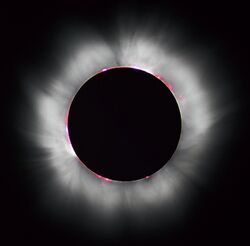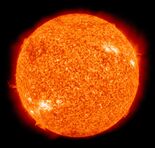Stellar atmosphere
Topic: Astronomy
 From HandWiki - Reading time: 5 min
From HandWiki - Reading time: 5 min
Short description: Outer region of the volume of a star
The stellar atmosphere is the outer region of the volume of a star, lying above the stellar core, radiation zone and convection zone.
Overview
The stellar atmosphere is divided into several regions of distinct character:
- The photosphere, which is the atmosphere's lowest and coolest layer, is normally its only visible part.[1] Light escaping from the surface of the star stems from this region and passes through the higher layers. The Sun's photosphere has a temperature in the 5,770–5,780 K (5,500–5,510 °C; 9,930–9,940 °F) range.[2][3] Starspots, cool regions of disrupted magnetic field, lie in the photosphere.[3]
- Above the photosphere lies the chromosphere. This part of the atmosphere first cools down and then starts to heat up to about 10 times the temperature of the photosphere.
- Above the chromosphere lies the transition region, where the temperature increases rapidly on a distance of only around 100 km (62 mi).[4]
- Additionally, many stars have a molecular layer (MOLsphere) above the photosphere and just beyond or even within the chromosphere.[5] The molecular layer is cool enough to contain molecules rather than plasma, and may consist of such components as carbon monoxide, water vapor, silicon monoxide, and titanium oxide.
- The outermost part of the stellar atmosphere, or upper stellar atmosphere, is the corona, a tenuous plasma which has a temperature above one million Kelvin.[6] While all stars on the main sequence feature transition regions and coronae, not all evolved stars do so. It seems that only some giants, and very few supergiants, possess coronae. An unresolved problem in stellar astrophysics is how the corona can be heated to such high temperatures. The answer is believed to lie in magnetic fields, but the exact mechanism remains unclear.[7]
- The astrosphere, which is in the case of the Sun the heliosphere,[8] can be in a broader understanding considered the furthest part of a stellar atmosphere,[9][10] before interstellar space begins at the heliopause. The astrosphere is not to be confused with the Solar System and its outermost region the Oort cloud, which extends much further than the astrosphere, therefore far into interstellar space.
During a total solar eclipse, the photosphere of the Sun is obscured, revealing its atmosphere's other layers.[1] Observed during eclipse, the Sun's chromosphere appears (briefly) as a thin pinkish arc,[11] and its corona is seen as a tufted halo. The same phenomenon in eclipsing binaries can make the chromosphere of giant stars visible.[12]
See also
- Cecilia Payne-Gaposchkin, who first proposed the presently-accepted composition of stellar atmospheres
- Circumstellar envelope
- Heliosphere
Notes
- ↑ 1.0 1.1 ""Beyond the Blue Horizon" – A Total Solar Eclipse Chase". 1999-08-05. https://www.sciencedaily.com/releases/1999/08/990805111308.htm. "On ordinary days, the corona is hidden by the blue sky, since it is about a million times fainter than the layer of the sun we see shining every day, the photosphere."
- ↑ Mariska, J. T. (1992). The solar transition region. Cambridge Astrophysics Series. Cambridge University Press. ISBN 978-0-521-38261-8. https://cambridge.org/catalogue/catalogue.asp?isbn=9780521382618&ss=toc.
- ↑ 3.0 3.1 Lang, K. R. (September 2006). "5.1 MAGNETIC FIELDS IN THE VISIBLE PHOTOSPHERE". Sun, earth, and sky (2nd ed.). Springer. p. 81. ISBN 978-0-387-30456-4. "this opaque layer is the photosphere, the level of the Sun from which we get our light and heat"
- ↑ Mariska, J. T. (1992). The solar transition region. Cambridge University Press. p. 60. ISBN 978-0-521-38261-8. "100 km suggested by average models"
- ↑ Tsuji, Takashi (2006). "Infrared Spectra and Visibilities as Probes of the Outer Atmospheres of Red Supergiant Stars". The Astrophysical Journal 645 (2): 1448–1463. doi:10.1086/504585.
- ↑ R.C. Altrock (2004). "The Temperature of the Low Corona During Solar Cycles 21–23". Solar Physics 224 (1–2): 255. doi:10.1007/s11207-005-6502-4. Bibcode: 2004SoPh..224..255A. https://zenodo.org/record/1232838.
- ↑ "The Sun's Corona – Introduction". NASA. http://imagine.gsfc.nasa.gov/docs/science/mysteries_l1/corona.html. "Now most scientists believe that the heating of the corona is linked to the interaction of the magnetic field lines."
- ↑ Sterken, Veerle J.; Baalmann, Lennart R.; Draine, Bruce T.; Godenko, Egor; Herbst, Konstantin; Hsu, Hsiang-Wen; Hunziker, Silvan; Izmodenov, Vladislav et al. (2022). "Dust in and Around the Heliosphere and Astrospheres". Space Science Reviews (Springer Science and Business Media LLC) 218 (8). doi:10.1007/s11214-022-00939-7. ISSN 0038-6308.
- ↑ "Sun: Facts". 2017-11-14. https://science.nasa.gov/sun/facts/.
- ↑ "Components of the Heliosphere". 2013-01-25. https://www.nasa.gov/image-article/components-of-heliosphere/#:~:text=influence%20in%20space.-,The%20Heliosphere%20is%20the%20outer%20atmosphere%20of%20the%20Sun%20and,planets%20in%20our%20solar%20system..
- ↑ Lewis, J.S. (2004-02-23). Physics and chemistry of the solar system (Second ed.). Elsevier Academic Press. p. 87. ISBN 978-0-12-446744-6. "The dominant color is influenced by the Balmer radiation of atomic hydrogen"
- ↑ Griffin, R.E. (2007-08-27). Hartkopft, W.I.; Guinan, E.F.. eds. Only Binary Stars Can Help Us Actually SEE a Stellar Chromosphere. 2 (1 ed.). Cambridge University Press. 460. doi:10.1017/S1743921307006163. ISBN 978-0-521-86348-3.
 |
Licensed under CC BY-SA 3.0 | Source: https://handwiki.org/wiki/Astronomy:Stellar_atmosphere6 views | Status: cached on October 05 2024 22:28:11↧ Download this article as ZWI file
 KSF
KSF


